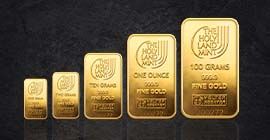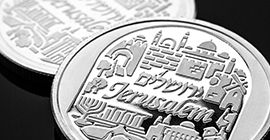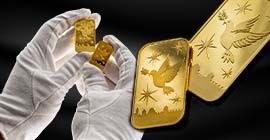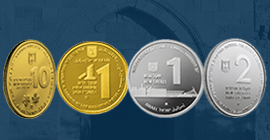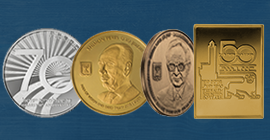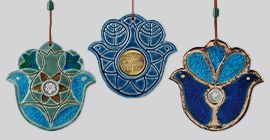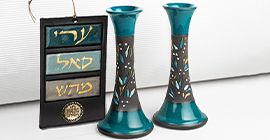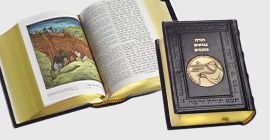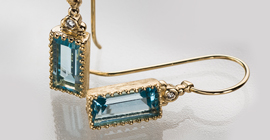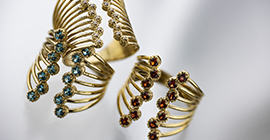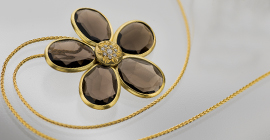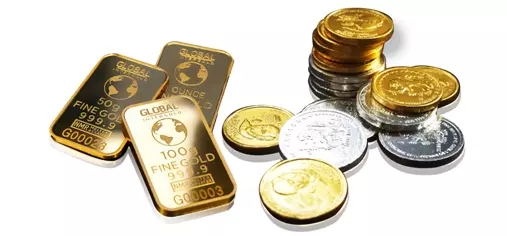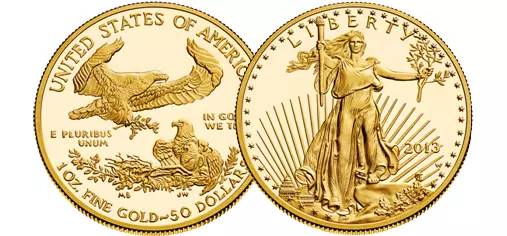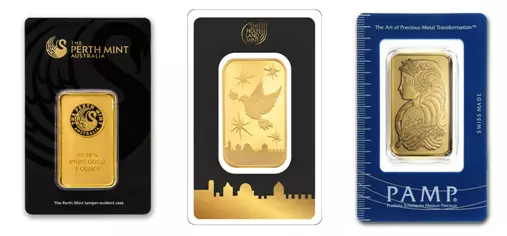History Of Gold, Part 1: The Sparkling Metal That Has Become The Strongest Currency In The World
Gold's glittering aura accompanies human culture from its inception. Even gold flakes were found in caves where humans lived 40,000 years ago. The attractiveness of gold in the eyes of man is closely linked to its natural properties. The way is created in nature, the fact that it is very rare and its remarkable durability have made it the most prestigious metal and through an investment and the payment of a premium. In this article we will follow the path of gold from ancient Egypt to the middle Ages, and we will also learn why and how the yellowish metal became the strongest currency in the world.
The earliest evidence for the use of gold for decoration, worship and preservation purposes comes from ancient Egypt, around 3,000 BCE. Egypt was a land rich in gold and the mining industry in the Nile region existed even then. The Egyptians attributed magical virtues to gold and it was an essential element in local mythology - a symbol of eternal heaven with celestial qualities. Gold is widely used in sculptures, jewelry and ritual objects. Few of them survived, but a large treasure weighing more than a ton of gold was found in the tomb of Pharaoh Tutankhamun.
The deep meaning of gold is also evident in the Bible, where it is mentioned dozens of times as a sign of perfection, holiness or as a means of payment. For example, gold appears in the story of the Garden of Eden to describe abundance. It is a central element in the calf worship of the Israelites who imitated Egyptian customs, and also in describing the extraordinary fortune of King Solomon and the splendor of the Temple he built: "And Solomon poured out the house inward, with closed gold; and he shall pass over with gold, before the sword, and shall cover it with gold. And the whole house was full of gold” (Kings 1: 6).
Gold and silver coins, gold bars, bulk.
The invention of gold coins
The measurement of the value of gold began with the Egyptians, who were the first to establish an agreed-upon ratio between it and another precious metal, silver. The idea that the two metals are competing and complementary assets was created then, and the value ratio between them is of immense economic significance even today. But the use of gold for commercial purposes did not begin in Egypt, but a little later on the other side of the Mediterranean. According to the Greek historian Herodotus, gold and silver coins were first minted in the sixth century BCE in the kingdom of Lydia that existed in modern western Turkey.
The uniqueness, usefulness and power of ingots and coins made of gold and silver have caused their rapid spread throughout the world. First the merchants recognized the value of gold and silver, followed by the rulers who realized that the big popularity of these metals could be used to promote their interests. In the empires of Greece, Rome and Persia, kings and emperors benefited from the new means of gaining control and influence, by issuing coins bearing their portraits and establishing laws requiring to use only them.
The countries traded gold with each other or took over it in the wars. For example, the conquest of Persia by Alexander the Great led to the winning of vast gold reserves. In the process, uniform standards of size and weight were created for the various currencies and disputes were resolved that precluded the business use of metals for trading and value preservation purposes.
Noble metal, beautiful and rare
Gold's natural properties made it the perfect means of payment, surpassing a wide range of other materials and objects, including seashells, grain and other metals like silver or copper. The first reason for the victory of gold is that it is a flexible metal that can be melted and shaped into coins or ingots. An important reason for this is its exceptional durability. This feature ensures that almost all the gold ever mined still exists and is available for use. Gold hardly reacts with other materials, so it can be found in its pure form in nature and also stored in complete safety. Accordingly, gold belongs to the exclusive club of the noble metals. Its unique color, yellowish-reddish - sets it apart from other metals, most of which are black or gray. From the moment set in human consciousness, gold has become a spectacular material to which humanity attaches eternal value.
Gold is distinguished by another important feature that has irreversibly affected its position in the trading world: rarity. Like any commodity, when there is a great demand but limited supply - the price goes up. The more limited the supply, the higher the price. Gold outperformed other means of payment, such as their supply being almost unlimited like shells or barley. Gold also has greater value than silver metal, whose supply is significantly larger than gold supply.
To date, about 190,000 tons of gold have been mined in the world, the equivalent of a 21 meter cube in total. It is estimated that another 50,000 tons of undigested gold are buried in the ground. The gold is found in rocks, soil or water in the form of lumps, powder or granules. The world's largest gold deposits have been discovered in China, the United States, Russia and Australia.
Gold is also, literally, an out-of-this-world material. The process of creating gold took place throughout the universe and is another expression of the uniqueness of this glowing metal. Scientists estimate that gold formed in distant galaxies billions of years ago, in a powerful explosion of particularly heavy stars at the end of their days, known as a supernova, or in a collision between two compressed neutron stars. The gold crumbs created in these rare cosmic events wandered in space and reached Earth like real stardust.
The rarity of gold gave birth to the desire to create an unlimited abundance of it. Alchemists have tried, and of course failed, to extract gold from compounds of other materials, available and cheaper such as lead or copper. Over the years, there has been widespread belief in the existence of the magical "Philosophers Stone" from which gold can be extracted. The same stone was "discovered" only in the 20th century. Through nuclear physics, there is an ability to produce metal close to gold, but it is an expensive, cumbersome and uneconomical process.
Stable asset with no substitute
After reviewing the natural properties of gold, we can understand the economic explanation for turning it into a top-notch asset and means of payment. According to monetary theory, in order to be a means of payment and savings one must have, among other things, two main features: People should agree to accept and give the means of payment in exchange for goods and services (Medium of exchange) and it should be reliable and stable enough to maintain its value over time (Store of value).
Nowadays the money issued by the various governments has received the status of Medium of exchange, although some critics argue that this is a problematic method that allows governments to print money out of control. Also, due to the exposure of government money to inflation, its status as a store of value is limited to relatively short periods of time.
In ancient times it was obvious that even if the coins of the rulers were the sole means of payment, a device for buying goods or hoarding money had to draw its power from other sources and be of substantial and independent value. Thus, the strong and rare gold that cannot be counterfeited has gained an irreplaceable status. Gold does not depend on governments or markets, wars, disasters or economic collapses. On the contrary, the value of gold tends to rise in periods when other assets lose value. Anyone who holds gold knows that he holds a stable, safe and long-term valuable asset that has already proven itself as such in the last thousands of years.
From right to left: Perth Mint Gold Bar, Dove of Peace Gold Bar and Lady Fortuna Gold Bar.
Gold is conquering Europe
Over the years, two major molds for gold casting have been created. One is for the relatively heavy ingots, which are kept in basements and safes as a means of accumulating long-term capital, the other is for gold jewelry used to showcase and demonstrate wealth. Gold coins were minted in parallel with the gold bullion. The weight of the coins is light so it is convenient to carry them and move them from hand to hand. Gold coins were suitable for trading in markets, transporting wealth from city to city or country to country and their popularity soared immediately after they were invented in the ancient kingdom of Lydia - and remains at its peak to this day.
We have already mentioned that silver coins were also minted in the kingdom of Lydia. This is because due to the rarity of gold there has been a demand for additional means of payment for trading purposes. If gold is "money" in large bills, there is also a need for "small money" - and the metal of silver was especially suitable for this purpose. It is interesting to note that in Hebrew, the word for "money" is the same for the word "silver", a word that has come to represent a means of payment.
The Romans minted the gold coin Aurios, which was the same size as the denarius coin made of silver but worth 25 times as much. Over the years, the Aurius has been replaced by other gold coins, such as the gold dinar of the Muslim Empire. In northern European countries silver coins occupied a more significant place, but from the moment the gold began to flow to them they too were conquered in its glittering aura.
An important moment in the development of gold occurred in the early days of the Renaissance, in 13th century Italy. Two rich cities, Venice and Florence, minted the ducat and the florin - coins of high gold quality that had never been seen before. Based on the Florence Banking Network, the Florin gained popularity and become legal tender all over Europe. For the first time, there was a world-class currency in the world. The success of Florin has led various countries to copy it, such as Hungary that issued the forint. With the discovery of America another abundant source of the glittering metal was discovered and the palaces of Europe were filled with gold.
The finest gold coins were the economic platform for the flourishing of trade and art during the Renaissance. In the following centuries the gold standard developed, which was gradually adopted by most countries and was the anchor for a period of relative peace, open borders and prosperous trade. In the next article we will tell the story of the golden age, a unique and inspiring period in economics and culture.
Shop gold for investment now >>
Contact one of our representatives >>
The information contained in this website should not be construed as investment advice or as a substitute for investment advice suited to your own individual financial needs for purchase or investment, investment activities or transactions, or as recommendations or opinions as to the benefits of investing in gold or in any other specific products. The information contained in this website does not constitute an alternative for investment advice and you should not act upon it, before seeking advice adapted to your own personal situation and needs.

